We Answer Your Top 10 Most Asked Helicopter Questions

If you’ve ever looked up at the sky and wondered about the incredible machines that can hover, fly backward, or land in the most remote locations, you’ve come to the right place. From helicopter history to hieroglyphic mystery, we’ve got it all covered here.
Whether you’re an aviation enthusiast, an aspiring pilot, or simply a curious mind with an insatiable need to know, fasten your seatbelt and get ready to soar through the skies of knowledge as we answer your top ten most asked helicopter questions!
1. WHEN WAS THE HELICOPTER INVENTED?
The concept of a helicopter, which is an aircraft capable of vertical takeoff and landing, dates all the way back to ancient times. However, the modern helicopter as we know it today was developed much more recently in the early 20th century.
The first practical helicopter, known as the “Focke-Achgelis Fa 61,” made its maiden flight on June 26, 1936. It was designed by German engineer Heinrich Focke and his collaborator, Gerd Achgelis. The Fa 61 featured twin rotors that were mounted one above the other on a single mast. This configuration canceled out the torque that is typically produced by a single-rotor helicopter, making it much more stable in flight.
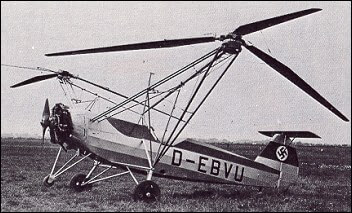
A prototype of the Fa 61—the first practical helicopter ever invented.
While the Fa 61 was a significant achievement, it was not until the mid-20th century that helicopters became more widespread and technologically advanced. To learn more about the early origins of vertical flight, check out our fascinating post on the general history of the helicopter.
2. WHEN WERE HELICOPTERS FIRST USED IN WAR?
While still in their early stages of development, helicopters began seeing military use during World War II. The first mass-produced helicopter, the Sikorsky XR-4, was also the first helicopter in war. The XR-4 was deployed by the United States Army Air Forces (USAAF) and the United States Coast Guard in various theaters of the war and used primarily for search and rescue missions, as well as for limited transportation and observation roles.
One significant mission involving helicopters during World War II was the rescue of downed pilots in Burma (now Myanmar) in 1944. Known as the “flying ladders” operation, Sikorsky XR-4 helicopters were used to extract wounded and stranded pilots from difficult terrain and bring them to safety.
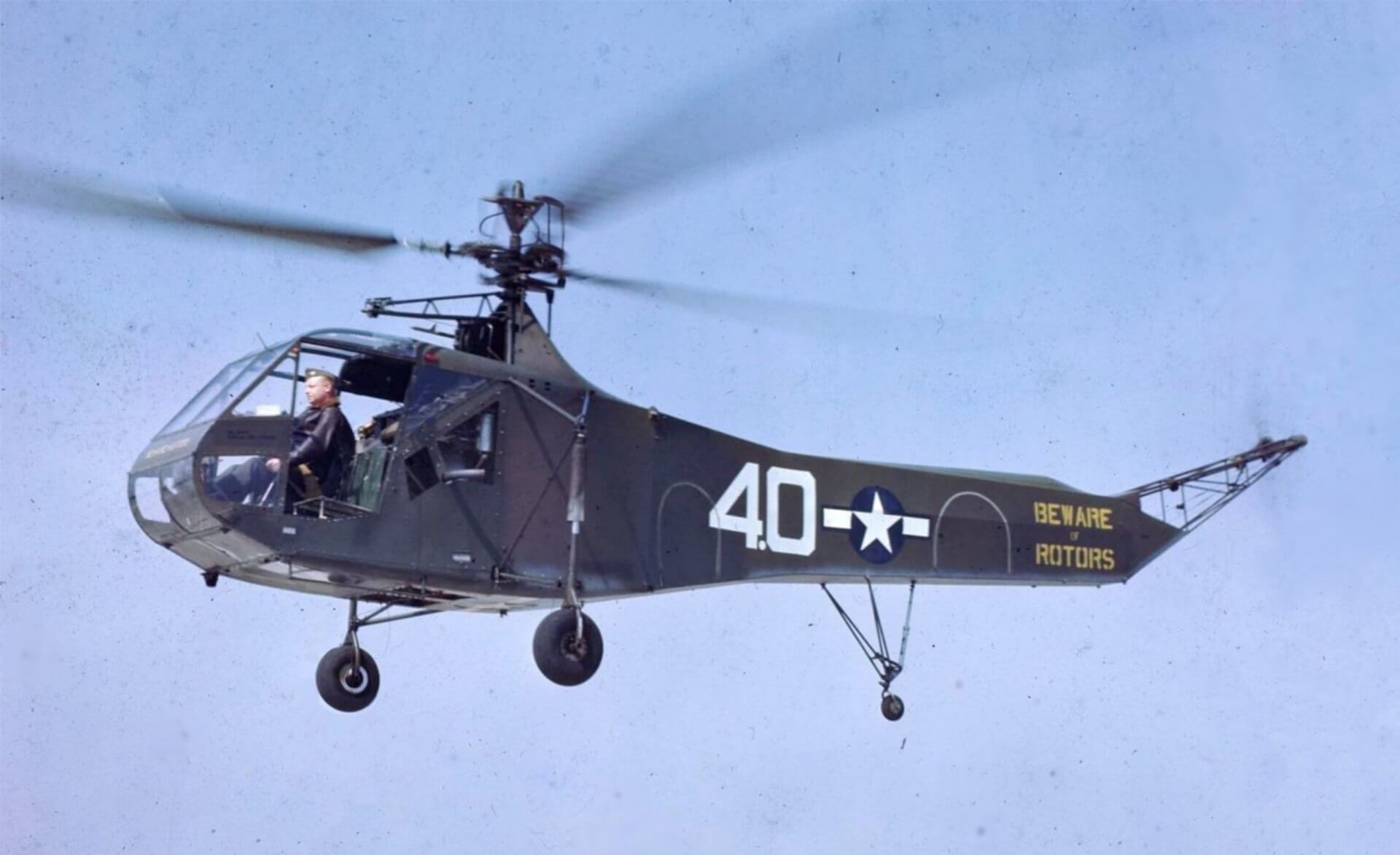
A Sikorsky XR-4 USAAF—the first mass-produced helicopter used in war.
While helicopters were present during World War II, it’s important to note that their role was relatively limited compared to other aircraft such as fixed-wing airplanes. It wasn’t until later conflicts—particularly the Korean War and Vietnam War—that helicopters played a more significant role in military operations. To learn more, we recommend reading our post on the history of helicopters in the military.
3. WHAT IS THE FASTEST HELICOPTER IN THE WORLD?
As of June 2023, the fastest helicopter in the world is the Eurocopter X³ (also known as the Airbus Helicopters X³). The X³ set a speed record for helicopters back on June 7, 2013, by reaching a top speed of 255 knots (293 mph or 472 kph) in level flight.
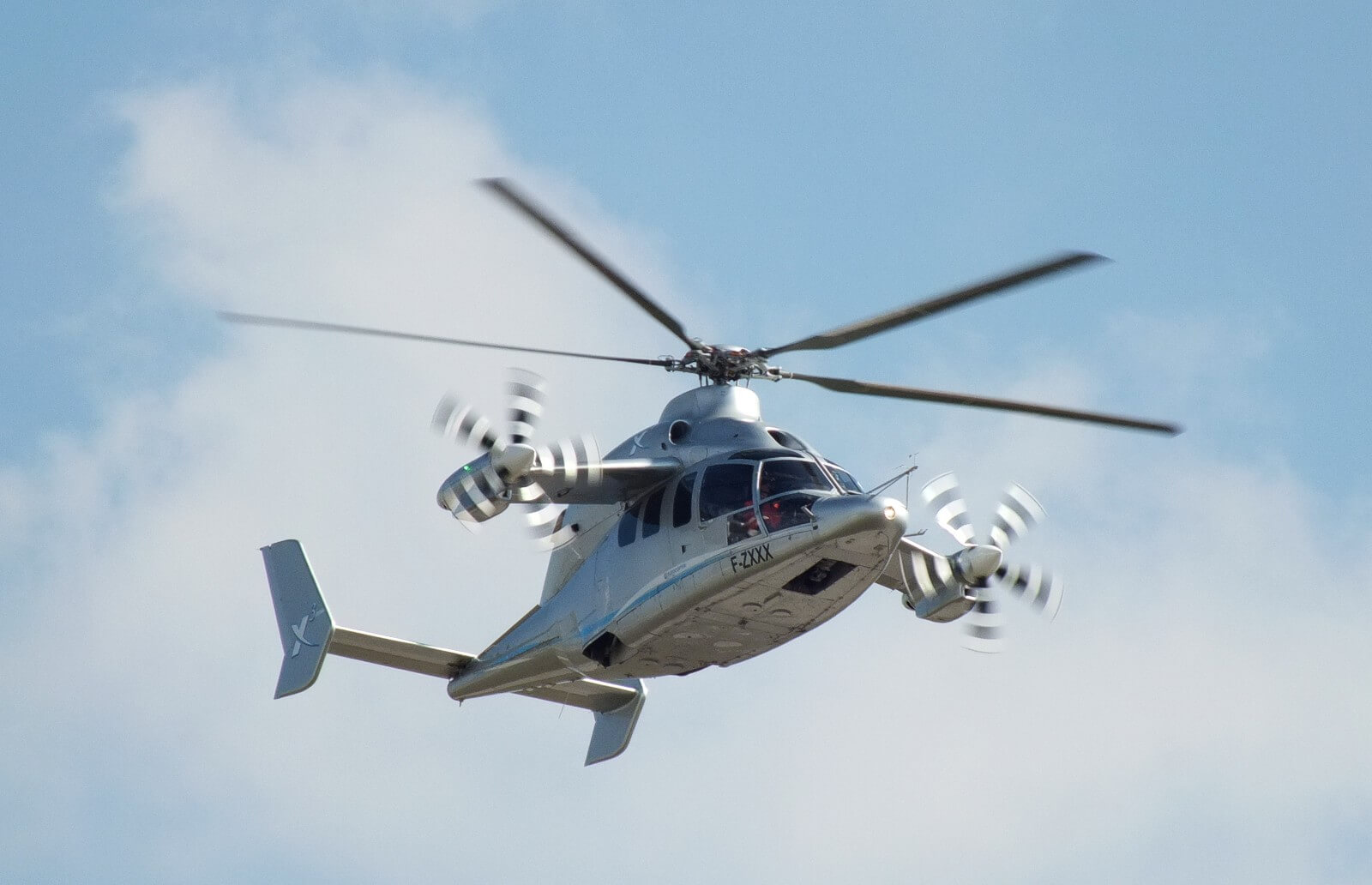
The Eurocopter X³—the fastest helicopter in the world.
The Eurocopter X³is a high-speed compound helicopter that combines rotorcraft and fixed-wing aircraft technologies. It achieves this remarkable speed by utilizing two turboshaft engines to power both a main rotor and two propellers mounted on short, fixed wings.
Of course, if we open this question up to all aircraft capable of vertical takeoff and landing, the fastest model is the Bell Boeing V22 Osprey by a wide margin. As a tiltrotor design, it can reach the blistering speed of 316 mph (509 kph) in helicopter mode, or transition into airplane mode—in just 12 seconds’ time—for an additional boost to 351 mph (565 kph).
4. WHAT IS THE BIGGEST HELICOPTER IN THE WORLD?
As of June 2023, the biggest helicopter in the world is the Mil Mi-26, a Russian heavy-lift cargo helicopter. Also known as the “Halo,” the Mi-26 has held the title of the world’s largest helicopter for several decades. It is primarily used for transporting heavy cargo, including military equipment, humanitarian aid, and oversized loads.
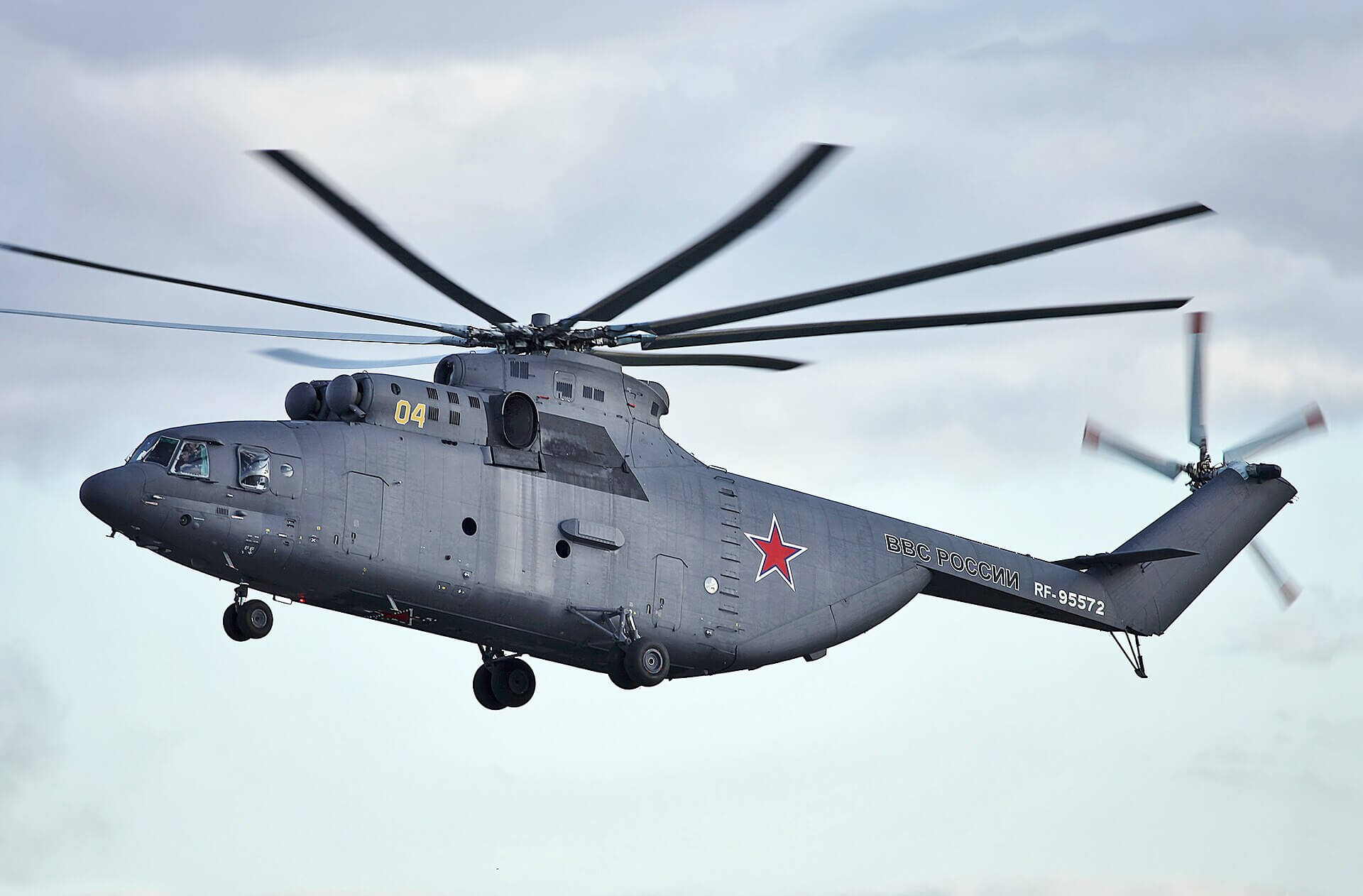
A Russian Air Force Mil Mi-26—the biggest helicopter in the world.
The Mil Mi-26 has a maximum takeoff weight of around 56,000 kg (123,500 lbs.) and a maximum payload capacity of approximately 20,000 kg (44,000 lbs.). It is powered by two mighty turboshaft engines and features an eight-blade main rotor system. The helicopter has a length of about 40 meters (131 ft) and a height of around 8 meters (26 ft).
As for the largest U.S. helicopter, that honor goes to the Sikorsky CH-53K King Stallion. The King Stallion is an advanced heavy-lift helicopter developed for the United States Marine Corps, to replace the aging CH-53E Super Stallion fleet in the future.
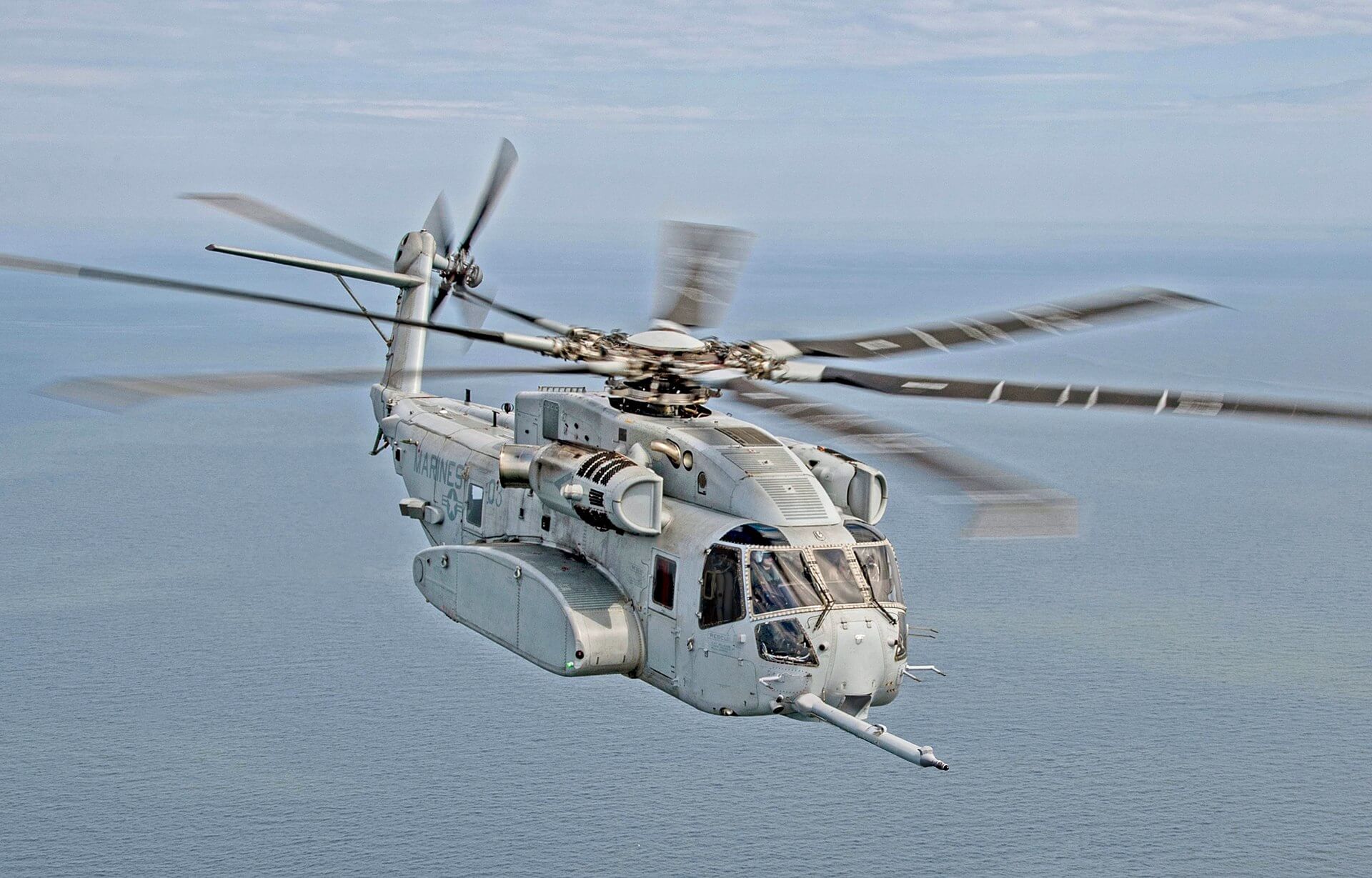
A Sikorsky CH-53K King Stallion—the largest U.S. helicopter.
The CH-53K King Stallion has a maximum takeoff weight of approximately 39,000 kilograms (86,000 pounds) and a maximum payload capacity of around 16,000 kilograms (35,000 pounds). It features three powerful turboshaft engines, a seven-blade main rotor system, and advanced technologies for enhanced performance, reliability, and maintainability.
5. HOW HIGH CAN A HELICOPTER FLY?
The maximum altitude that a helicopter can achieve depends on various factors, including its design, engine power, weight, and environmental conditions. That’s because, as a helicopter climbs to higher altitudes, the air becomes thinner, resulting in reduced engine performance and rotor efficiency. Therefore, the higher a helicopter flies, the more limited its lifting capacity becomes.
Generally, helicopters are capable of flying up to altitudes ranging from 10,000 to 25,000 feet (3,000 to 7,600 meters) above sea level. Certain specialized helicopters, such as high-altitude reconnaissance or utility helicopters, may have specific modifications or equipment—like more powerful engines, improved rotor designs, or even auxiliary systems like oxygen supplies to support operations in thin air—to enable them to operate at higher altitudes.
The previously mentioned Eurocopter X³, for instance, has demonstrated the ability to reach altitudes exceeding 37,000 feet (11,000 meters). However, such helicopters are not commonly used for practical applications and are designed with specific high-altitude performance goals in mind.
6. WHAT ALTITUDE DO HELICOPTERS FLY AT?
For general operations such as transportation, reconnaissance, or patrol, helicopters commonly fly at altitudes ranging from a few hundred feet to a couple of thousand feet above the ground. This allows for maximum visibility, safety, and maneuverability.
It’s important to note that this altitude range is approximate and can vary based on a pilot’s professional judgment when considering the following factors:
- Mission Requirements: The nature of the operation can play a crucial role in determining helicopter altitude. For example, a helicopter involved in surveillance or close air support may need to fly at lower altitudes to maintain visual contact. Alternatively, a long-range transport mission may require flying at higher altitudes to cover larger distances more efficiently.
- Safety Considerations: Safety is always paramount when it comes to helicopter operations. In congested airspace or urban areas, helicopters may need to fly at lower altitudes to maintain separation from other aircraft and ensure safe operations. Similarly, in mountainous regions, helicopters may need to navigate at specific altitudes to avoid terrain obstacles.
- Performance and Power Limitations: All helicopters have their performance limitations, especially as the altitude increases. Pilots must consider their specific helicopter’s performance capabilities, such as climb rate, hover ceiling, and payload when determining their ideal operational altitude.
- Environmental Conditions: Weather conditions, such as wind speed, temperature, and atmospheric pressure can impact helicopter operations and altitude selection. Strong winds or adverse weather conditions may necessitate flying at lower altitudes for improved stability, visibility, and control.
- Regulatory Restrictions: Aviation authorities establish regulations and airspace classifications that govern helicopter operations. These regulations may include minimum and maximum altitudes for specific areas or types of flights. Pilots must adhere to these regulations and consider any relevant restrictions when determining the appropriate altitude.
7. CAN HELICOPTERS FLY UPSIDE DOWN?
No, helicopters are not designed to fly upside down in the same way that fixed-wing aircraft can. Of course, there are specialized types of helicopters—such as the aerobatic helicopters used in helicopter airshows—that can perform limited inverted flight or other advanced maneuvers. However, such helicopters are not representative of the capabilities of standard helicopters used for general aviation or operational purposes.
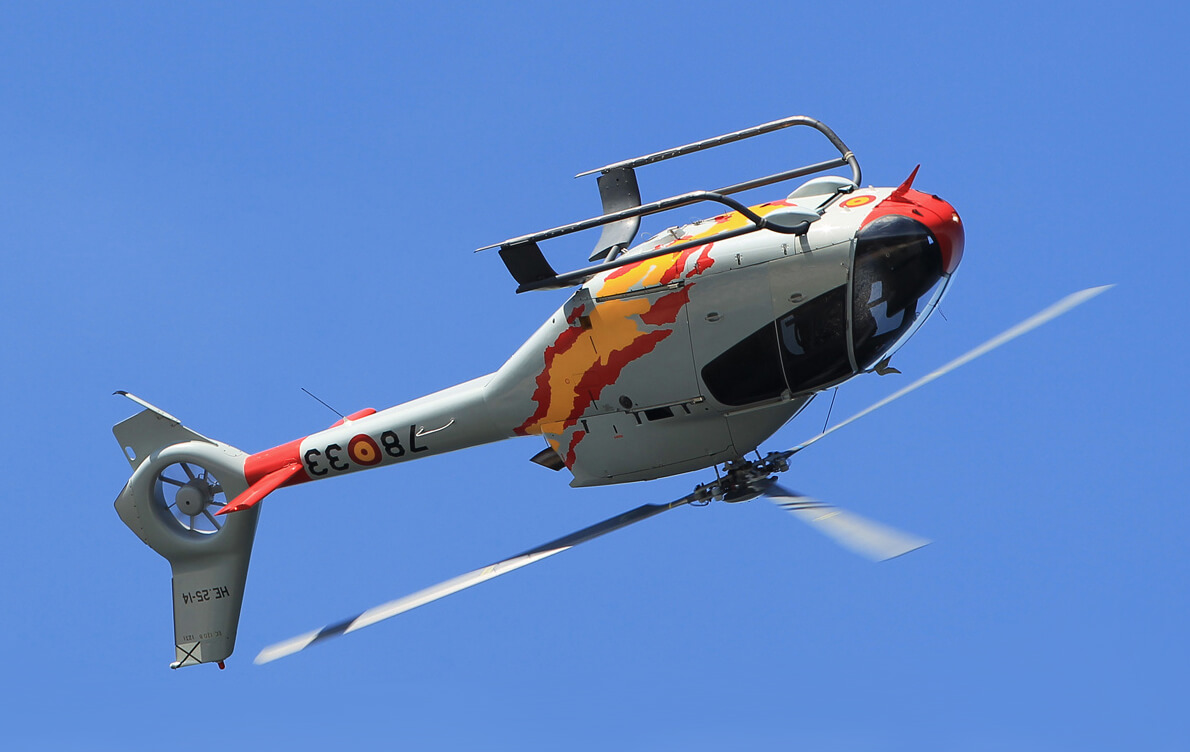
A Spanish Air Force Eurocopter EC120 (now Airbus H120) Colibri performing a barrel roll maneuver.
The main reason helicopters cannot fly upside down is due to the design and operation of their rotor system. The rotor blades of a helicopter generate lift by creating a pressure difference between the upper and lower surfaces of the rotor blades as they rotate. This lift is primarily directed vertically to support the weight of the helicopter and keep it airborne.
In order to fly upside down, the rotor blades would need to be inverted, and the lift generated would be directed in the wrong direction, pushing the helicopter toward the ground instead of supporting it. This configuration is simply not possible with the conventional rotor systems used in most helicopters.
8. ARE HELICOPTERS SAFER THAN PLANES?
Comparing the safety of helicopters and airplanes can be challenging, as both types of aircraft have their own unique characteristics and considerations. Rather than make a blanket statement about one being inherently safer than the other, let’s instead look at some key points to consider when discussing the safety of helicopters versus planes.
- Accident Rates: When you compare helicopter vs plane crash rates, helicopters tend to have higher accident rates. This is partly due to the different flight characteristics and operational environments of helicopters, which often involve low-level flight, off-airport landings, and more frequent takeoffs and landings. However, it’s important to note that accident rates can vary significantly depending on the specific helicopter model, the type of operation, and other factors.
- Crash Survival Rates: We’re not here to tell you how many people died in helicopter crashes last year. If that’s what you’re looking for, you can go elsewhere. What we will say is that helicopters, with their ability to hover and make controlled landings in confined spaces, may have an advantage in certain situations where a safe landing area can be found. However, airplanes generally have better crash survivability statistics due to their higher cruise speeds, better structural integrity, and more controlled landing environments.
- Pilot Skill and Training: The complexity and demands of helicopter operations often necessitate more rigorous training, experience, and piloting skills compared to airplanes. Helicopter pilots require proficiency in managing unique flight characteristics, such as hover, autorotation, and managing low-speed flight regimes for safe flying.
- Operational Environments: Helicopters are commonly used for tasks such as search and rescue, medical evacuation, and aerial construction work. Unfortunately, these operations often expose helicopters to challenging environments, including adverse weather, complex terrain, and limited landing options, which can pose additional safety risks.
- Regulatory Standards: Both helicopters and airplanes adhere to stringent safety regulations and certification standards. These regulations cover areas such as design, manufacturing, maintenance, and operational procedures. The aim is to ensure the safety of both aircraft types and mitigate any risks. Compliance with these regulations is critical to maintaining safety levels.
9. WHAT IS THE NAME OF THE PRESIDENT’S HELICOPTER?
The official helicopter used by the President of the United States is commonly referred to as Marine One. “Marine One” is the call sign used to identify any United States Marine Corps aircraft carrying the President when the President is on board.
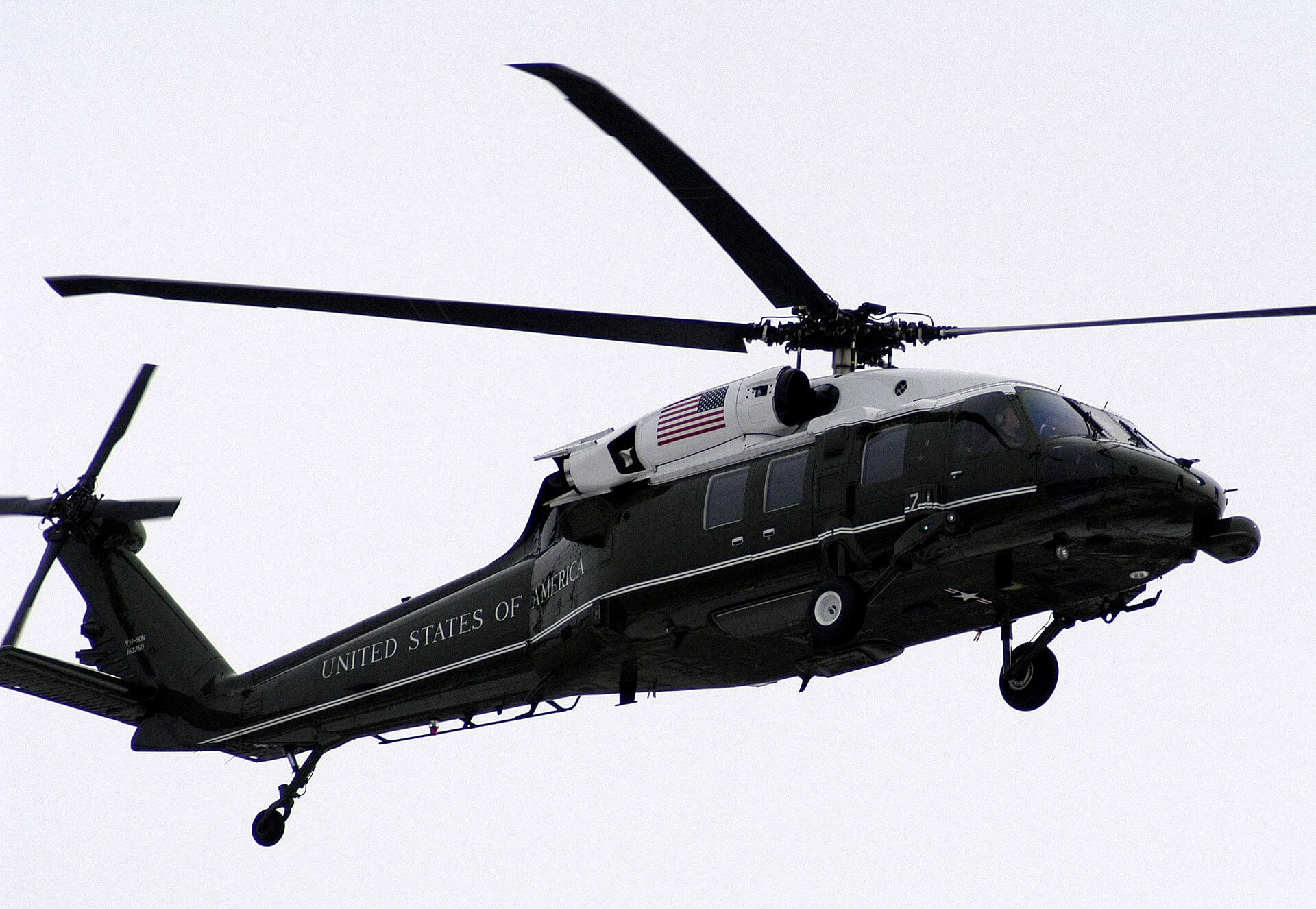
The President’s helicopter—A U.S. Navy Sikorsky Vh-60N White Hawk in flight.
The specific helicopter used for presidential transport is the Sikorsky VH-60N White Hawk, which is a heavily modified variant of the UH-60 Blackhawk. These helicopters are operated by the Marine Helicopter Squadron One (HMX-1), which is responsible for transporting the President, Vice President, and other VIPs.
10. WAS THERE A HELICOPTER IN EGYPTIAN HIEROGLYPHICS?
Hieroglyphics was a writing system used by the ancient Egyptians, primarily between 3,200 BCE and 400 CE. They consisted of a series of pictorial symbols that represented words or sounds. The imagery found in Egyptian hieroglyphics reflects the cultural and technological context of ancient Egypt. The depictions typically focused on elements of daily life, religious beliefs, mythological figures, and symbols of power and authority.
Since hieroglyphic script predates the invention of the helicopter by thousands of years, it’s hard to believe the ancient Egyptians had any knowledge or concept of such advanced aircraft. As such, it is incredibly unlikely that there are any hieroglyphs of helicopters.
With that said, a recent discovery in the Temple of Seti I at Abydos has many people claiming we’ve finally found definitive “proof” that time travel is achievable. The image, which you can see below, seems to depict several advanced forms of transportation. In addition to the “helicopter” in the top left corner, you could interpret carvings of a submarine (top middle), jet plane (bottom middle), and flying saucer (middle middle).

The hieroglyphic carvings in the Temple of Seti I at Abydos.
Of course, it’s important to approach claims of anachronistic depictions, such as helicopters or other modern technology, in ancient artwork or artifacts with skepticism. These interpretations often result from a combination of pareidolia—the tendency to perceive familiar shapes or patterns in random or ambiguous stimuli—and speculative or imaginative interpretations that are not supported by historical or archaeological evidence.
DON’T SEE THE ANSWER YOU’RE LOOKING FOR?
As we bring this helicopter FAQ to a close, we hope that your curiosity has been satisfied and your understanding of these remarkable machines has soared to new heights. Throughout our exploration, we’ve touched on the origins of helicopters, their record-setting feats, and the safety considerations that shape their everyday operations. If you still have a lingering question that needs answering, we encourage you to reach out to our team of helicopter pilots and experts.
Remember, the world of helicopters is ever evolving, with advancements in technology continually pushing the boundaries of what these aerial wonders can achieve. Whether they’re lifting off from bustling city helipads or venturing into the most remote corners of the Earth, helicopters continue to captivate our imaginations and remind us of the incredible possibilities that can be achieved when we take to the skies. So stay curious, keep your eyes on the horizon, and never lose sight of the awe-inspiring capabilities of helicopters.
If you’d like to keep learning, we invite you to check out our Chopper Spotter ground-handling FAQs. It’s jam-packed with helpful answers to many of our customers’ most-asked product questions. Because as always, our team is here to work closely with you to fully understand your aircraft and your application in order to modify our offering to meet your unique needs.